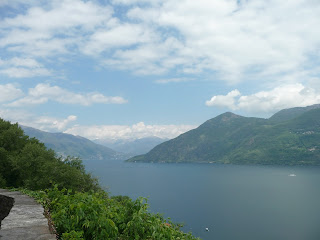Wednesday morning looked like this:
As the forecast was for unsettled weather and the clouds made us believe it, we decided on a shorter hike, rather a walk, which would not lead us too far away from opportunities for shelter. It turned out we did not need any shelter, as the day was quite beautiful, but we did not know that when we set off after breakfast.
Our walk (which was actually rather steep and challenging in some parts, not something you'd do for a leisurely stroll on a Sunday afternoon) took us south of Cannobio, on old mule paths in the woods, following the shoreline high up, via a village called Carmine Superiore to the next town, Cannero.
Along the way, I took too many pictures to pack into one post.
View of Cannobio soon after we started to walk:
A lot of it was through woodland (mainly chestnut trees), but in between there were many spots offering great views of the lake.
A tiny hamlet with an even tinier chapel, and what used to be the main flour mill for Cannobio (according to our little guide book). Imagine the people back then carrying sacks of grain up to the mill and the finished product back down every time, all on mules' backs - or their own.
Then the first glimpse of Carmine Superiore and its church. This medieval village is still not accessible by car. Some of its houses stand empty, but a lot of them have been lovingly restored and are now lived in; some permanently, some only in the summer.
I was pleased to find this blog about the place, and am going to explore it further as soon as I get the time.
The church (from around the year 1330, with most of the frescoes being painted in the 15th century) was locked, but there is a rather good description of it on the sign near the door. Also, a large window has been purpose-built into its back wall (you can't see it in the pictures). Putting a 1-Euro-coin into a slit in the wall turns the lights on inside the church, so that tourists can admire the frescoes.
The views from the terrace are beautiful:
Eventually, we moved on, leaving the village at its other end.
Our next stop was Cannero, which will be the subject of one of my next posts.
































It is all magic. The natural beauty and the man made.
ReplyDeleteIt certainly felt like it, Kristi.
DeleteWhat a super walk - so different from Baden-Württemberg or the Ripon area for that matter. Wonderful vistas and a palpable sense of history - long before there were any tourists there.
ReplyDeleteVery different indeed! What Yorkshire and that area do have in common, though, are the many drystone walls. You don't get to see those very often where I live.
DeleteLove.
ReplyDeleteHello Regine, I think this is your first comment on my blog - welcome! I have just had a quick look at yours. Thought-provoking is the first word that comes to my mind.
DeleteNo CARS are allowed there, sounds like heaven to me!
ReplyDeleteI went to the blog that you mentioned, I also will read it when I have the time...must run to get ready for work now though!
Take care!
It is less a point of cars not being allowed there as them not being possible - the paths are too steep and too narrow. When the village grew in medieval times, transport was on foot and by mule and maybe the occasional small farmer's cart.
DeleteI'm running out of coffee and time! I've really been hooked by these posts. I also went to visit Louise Bostock's blog. The name was very familiar. The blog ended 4 years ago and her career seems to have disappeared too. I shall have to do some more detective work. I think, too, that I shall look again (in an evening) at your photos using my large TV screen to enjoy them to the full.
ReplyDeleteI sent an email to her but never got a response, so I appreciate it if you let me know what you find out when you do some more detecting.
DeleteThe idea of someone looking at photos from my blog on a large screen makes me blush - it's an honour!